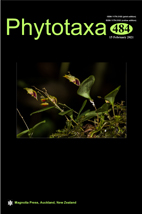Abstract
The genus Cocconeis is highly diverse and composed of several groups with distinctive morphologies. Several Cocconeis, characterized by complex areola occlusions, are here grouped under the new section Loculatae. The complex loculate areolae are either present on both valves, or most often only on the sternum valve (SV). Among the Loculatae taxa, some were described as varieties of Cocconeis scutellum, whereas others were assigned species rank. Critical SEM examination is required to correctly discriminate members of this section. Cocconeis tsara sp. nov. and C. santandrea sp. nov. are marine tropical benthic diatoms with loculate areolae justifying their membership to the proposed section. Based on ultrastructure, a cladistic analysis is performed to determine the relationships between these taxa. A traditional dichotomous tree based on the most particular features encountered on this group is constructed to aid in species determination. Several of the Loculatae taxa are epiphytic, one was observed as epizoic. The necessity of high resolution SEM to discern details of the SV areola occlusions and the raphe valve valvocopula (RVVC), and the nomenclatural descriptive terms used by authors, are discussed to better compare recent and historical descriptions.

